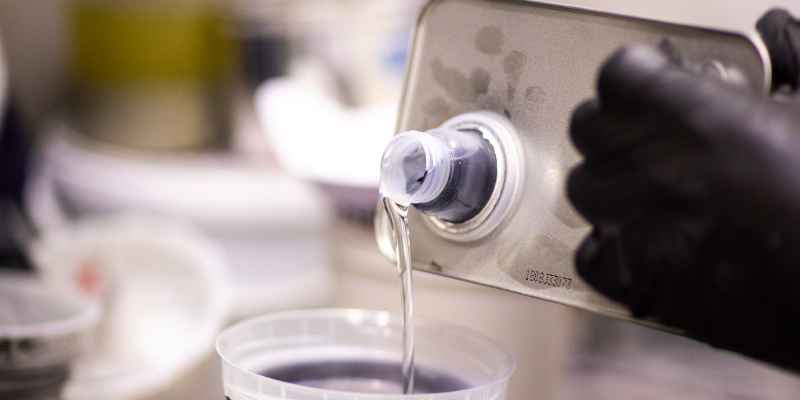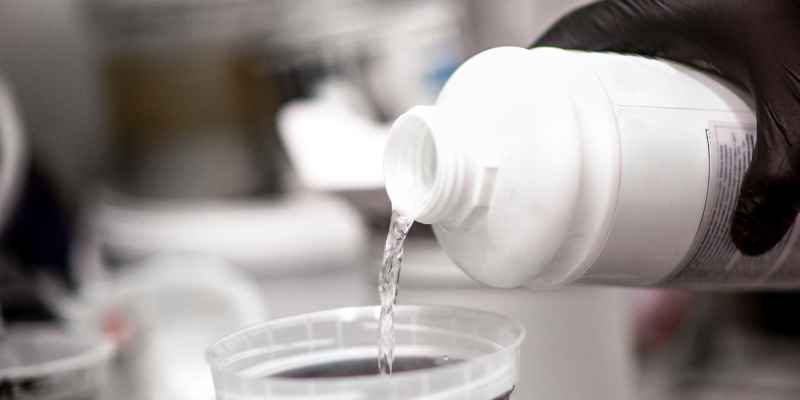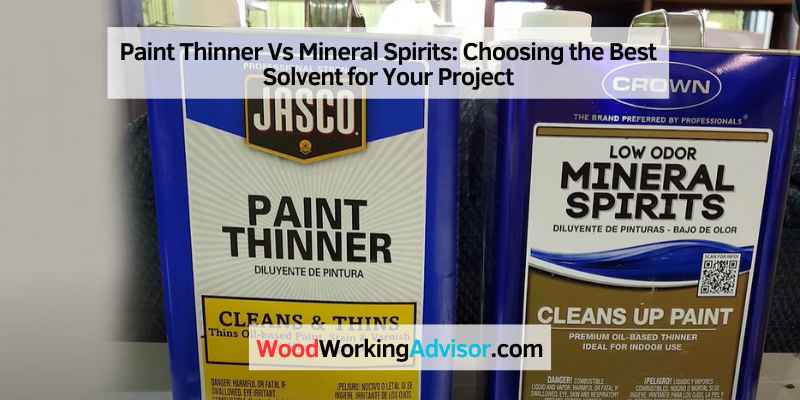Paint thinner and mineral spirits are both solvents used for thinning oil-based paints, but while paint thinner is a generic term for a variety of solvents, mineral spirits are a specific type of paint thinner that is derived from petroleum.
Key Differences Between Paint Thinner And Mineral Spirits
When it comes to cleaning and thinning paints, two common products that often come up are paint thinner and mineral spirits. While they may seem similar, it’s important to understand the key differences between these two solvents.
Chemical Composition
Paint thinner and mineral spirits vary in their chemical composition. Paint thinner is typically made from a mixture of solvents derived from petroleum, while mineral spirits are primarily composed of refined petroleum distillate. These differences in composition can influence their performance and effectiveness in various tasks.
Evaporation Rate
The evaporation rate is another characteristic where paint thinner and mineral spirits differ. Paint thinner has a higher evaporation rate, meaning it evaporates more quickly than mineral spirits. This faster evaporation rate makes paint thinner an ideal choice for projects where a quicker drying time is desired.
Odor
One noticeable difference between paint thinner and mineral spirits is the odor. Paint thinner tends to have a stronger and more pungent odor compared to mineral spirits. The distinct smell of paint thinner can linger longer in a well-ventilated area, while mineral spirits typically have a less offensive odor.
In conclusion, while paint thinner and mineral spirits are both solvents used for thinning paints and cleaning tools, they exhibit key differences in their chemical composition, evaporation rate, and odor. Understanding these differences can help you choose the right product for your specific needs.

Common Uses Of Paint Thinner
If you are a DIY enthusiast or a professional painter, understanding the common uses of paint thinner is essential. Paint thinner is a versatile solvent that serves multiple purposes in the world of painting. Whether you want to remove old paint or thin out oil-based paints for a smooth finish, paint thinner can be your go-to solution. In this post, we will explore two common uses of paint thinner: removing paint and thinning oil-based paints.
Removing Paint
One of the primary uses of paint thinner is for removing paint. Whether you accidentally spilled paint on a surface or want to strip an entire painted area, paint thinner is your trusty companion. It helps break down the pigments and binders in the paint, making it easier to remove. Keep in mind that the effectiveness of paint thinner in removing paint depends on the type of paint as well as the surface it is applied on.
Thinning Oil-based Paints
Unlike water-based paints, oil-based paints can sometimes have a thick consistency that makes them difficult to work with. This is where paint thinner comes in handy. By adding a small amount of paint thinner to the oil-based paint, you can achieve the desired consistency. Thinning the paint helps it spread more evenly and easily on surfaces, creating a smooth and professional-looking finish.
It is important to mention that while paint thinner is commonly used for thinning oil-based paints, it may not be suitable for other types of paints. Always check the label of the paint thinner and the paint itself to ensure compatibility before mixing them together.
Common Uses Of Mineral Spirits
Mineral spirits, also known as white spirits or mineral turpentine, is a versatile solvent commonly used in various applications. From cleaning brushes and tools to thinning and cleaning oil-based stains, mineral spirits can effectively tackle a range of tasks. In this section, we will explore the common uses of mineral spirits in more detail, starting with its role in cleaning brushes and tools.
One of the primary uses of mineral spirits is to clean brushes and tools after painting or applying varnish. When paint or varnish dries on brushes or tools, it can be challenging to remove. However, mineral spirits can easily dissolve and remove paint or varnish residues, making the cleaning process quick and easy.
Here’s how you can use mineral spirits to clean brushes and tools:
- Start by wearing protective gloves to avoid direct contact with the mineral spirits.
- Pour a small amount of mineral spirits into a clean container.
- Dip the brushes or tools into the mineral spirits, ensuring that the bristles or surfaces are fully submerged.
- Swirl the brushes or rub the tools against the sides of the container to loosen and remove any paint or varnish.
- Rinse the brushes or tools with warm water to remove any remaining mineral spirits and residues.
- Finally, let the brushes or tools air-dry before storing them for future use.
Cleaning brushes and tools with mineral spirits not only prolongs their lifespan but also ensures better performance in subsequent painting or varnishing projects. The solvent effectively removes any build-up or hardened residues, allowing for smoother application and cleaner results.
Alongside cleaning brushes and tools, mineral spirits also excel in thinning and cleaning oil-based stains. Oil-based stains can be thick and viscous, making them challenging to apply evenly. By using mineral spirits as a thinner, you can adjust the consistency of the stain to your desired level, allowing for better control when applying.
When it comes to cleaning oil-based stains, mineral spirits are highly effective in removing any excess or spilled stain. The solvent quickly dissolves the stain, making it easier to clean up and minimizing the risk of staining surrounding surfaces.
Here’s how you can thin and clean oil-based stains using mineral spirits:
- Measure the desired amount of oil-based stain into a clean container.
- Add a small amount of mineral spirits to the stain.
- Stir and mix well, gradually adding more mineral spirits if necessary, until you achieve the desired consistency.
- Once you finish staining, clean any excess or spilled stain by applying mineral spirits directly to the affected area, then gently scrubbing with a cloth or sponge.
- Wipe away the dissolved stain with a clean cloth, ensuring all traces are removed.
By utilizing mineral spirits as a thinner and cleaner for oil-based stains, you can achieve better control during the staining process and maintain a clean and tidy workspace.
Benefits Of Using Paint Thinner
When it comes to thinning paints and cleaning brushes, using paint thinner provides several advantages. Whether you are a professional painter or a DIY enthusiast, paint thinner can be a handy tool in your painting arsenal. Let’s explore some of the benefits of using paint thinner:
Lower Cost
One of the major advantages of using paint thinner is its cost-effectiveness. When compared to other paint thinning solutions, paint thinner is often more economical. The lower cost makes it a preferred choice for individuals and businesses looking to save money without compromising on quality.
Variety Of Formulations
Paint thinner comes in a wide range of formulations, offering versatility in its application. From general-purpose thinners to specialty formulations designed for specific paint types, there is a paint thinner solution for every project. This variety allows you to choose the right formulation based on your painting requirements, ensuring optimal results.
In addition, some paint thinner formulations are designed to have improved drying times or reduced odor, catering to different preferences and needs. Whether you are working with oil-based or latex paints, there is a paint thinner formulation that can effectively thin and clean your brushes.
Benefits Of Using Mineral Spirits
When it comes to cleaning up paint and varnish, many people are torn between using paint thinner or mineral spirits. While both options can effectively remove paint and thin coatings, mineral spirits offer several distinct advantages. Here are some key benefits of using mineral spirits:
Less Harsh Odor
One of the top advantages of using mineral spirits is the considerably less harsh odor compared to paint thinner. While paint thinner has a strong and pungent smell that can linger in the air for hours, mineral spirits have a milder and less offensive odor. This makes it more pleasant to work with, especially in indoor or enclosed spaces.
Improved Safety
Another significant benefit of mineral spirits is the improved safety it provides. Mineral spirits are less volatile and have a higher flash point compared to paint thinner. This means that mineral spirits are less likely to catch fire or explode, making them a safer option for storage and use. Additionally, their lower toxicity makes them less harmful to both human health and the environment.
Moreover, mineral spirits evaporate at a slower rate, allowing for a longer working time and reducing the risk of fire hazards. This stability makes mineral spirits an ideal choice for those who require extended periods to complete their painting projects or need to work in well-ventilated areas.
Furthermore, mineral spirits are compatible with a wide range of surfaces, including wood, metal, and plastic, making them versatile for various applications.
Overall, the use of mineral spirits presents numerous benefits over paint thinner. The reduced odor and improved safety make mineral spirits a more comfortable and reliable choice for cleaning, thinning, and removing finishes.

Frequently Asked Questions On Paint Thinner Vs Mineral Spirits
Can Paint Thinner Be Used Instead Of Mineral Spirits?
No, paint thinner cannot be used as a substitute for mineral spirits. They have different chemical compositions and properties. Ensure you use the appropriate solvent for your specific needs.
Should I Use Paint Thinner Or Mineral Spirits To Clean Paint Brush?
To clean a paintbrush, use mineral spirits or paint thinner. Both effectively remove paint residue.
Is Paint Thinner The Same As White Spirit?
No, paint thinner and white spirit are not the same. They have different chemical compositions and are used for different purposes. Paint thinner is used to thin oil-based paints, while white spirit is a petroleum-based solvent used for cleaning and degreasing.
Is Paint Thinner Good For Cleaning?
Paint thinner is effective for cleaning paint brushes and removing dried paint from surfaces. It helps to dissolve paint and make it easier to clean. However, it is important to use it in a well-ventilated area and follow safety instructions.
Always test on a small area before using it on delicate surfaces.
Conclusion
When deciding between paint thinner and mineral spirits, it is important to understand their differences and uses. While paint thinner is more potent and can remove tough paint stains, mineral spirits are gentler and suitable for general cleaning purposes. Ultimately, the choice depends on the specific task at hand and personal preference.
Consider the surface you are working on and the type of paint you are using. Ultimately, both options have their merits and can be effective in various scenarios.


